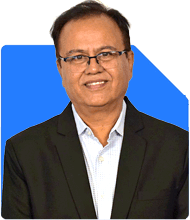Ramalingam Kalirajan |10881 Answers |Ask -Follow
Mutual Funds, Financial Planning Expert - Answered on Jun 24, 2025
He has an MBA in finance from the University of Madras and is a certified financial planner.
He is the director and chief financial planner at Holistic Investment, a Chennai-based firm that offers financial planning and wealth management advice.... more

Hello Sir, I am 32 years old and my investments are. SIP of monthly Rs 26000/- (Small, Mid, Large Cap and Debt Fund) Current value of SIP is Rs 2500000, XIRR 24.5% SIP in Gold Rs 3000 per month, Current Value Rs 45000 SIP in Stock Rs 3000 per month Current Value Rs 55000. SIP on name of Mother Rs 15000 SIP Monthly Current Value Rs 2.75Lakh. PF Value Rs 800000 Plot current value Rs 3500000 Own House No Loan or EMI My Salary Is Rs 75000 and monthly expense is Rs 15000Rs And the rest money is saved as Emergency fund which is around 2.5 Lakh. Please suggest.
Current Investment Snapshot
SIP total Rs?26,000/month across small, mid, large?cap, debt funds.
Current SIP corpus typically around Rs?25?lakhs with XIRR 24.5%.
SIP in gold Rs?3,000/month, current value ~Rs?45,000.
SIP in direct stock Rs?3,000/month, current value ~Rs?55,000.
SIP by mother in your name Rs?15,000/month, current value ~Rs?2.75?lakhs.
Provident Fund (PF) balance ~Rs?8?lakhs.
Plot worth ~Rs?35?lakhs.
Own house, loan/EMI free.
Salary Rs?75,000/month, monthly expense Rs?15,000.
Emergency fund ~Rs?2.5?lakhs.
You have strong savings capacity of ~Rs?60,000/month. You manage money well. Let me assess each area and give balanced suggestions.
1. Portfolio Diversification and Allocation
Your equity SIP (Rs?26?k + Rs?3?k direct stock + Rs?15?k mother’s SIP) is ~Rs?44 k/month.
Debt SIP is only part of the Rs?26 k; exact split unclear.
Gold SIP is small, giving just Rs?45 k so far.
PF is long?term debt component.
Plot is illiquid; avoid more real estate.
Assessment:
Equity exposure is high and performing great.
Debt exposure seems low; balance is needed.
Gold holding small; can be increased modestly for diversification.
PF offers retirement cushion but adds to debt component.
Suggestions:
Aim for equity 60%, debt 30%, gold 10% allocation.
Increase debt SIP by Rs?5–10 k/month (dynamic bond, corporate bond, flexi-debt fund).
Increase gold investment to Rs?5–7 k/month till allocation reaches 8–10%.
Continue equity SIPs as they yield high XIRR.
Reallocate mother’s SIP distribution if concentrated in one fund.
2. Importance of Debt Exposure
Debt funds offer stability, liquidity, lower risk.
At present, your exposure is limited.
During market volatility, debt cushions equity downside.
Why it matters:
You have a sharp portfolio tilt to equity.
Market corrections could reduce corpus significantly.
Debt helps smooth returns over down cycles.
Action plan:
Start SIP in dynamic bond fund or corporate bond fund.
Allocate Rs?5–10 k/month depending on comfort.
Review debt holdings once every 6–12 months.
3. Gold Allocation Strategy
Current gold SIP is small (Rs?3 k/month).
Current market value ~Rs?45 k; you just began.
Gold reduces portfolio correlation with equity.
Advantages of more gold:
Acts as inflation hedge.
Provides downside protection.
Steps:
Increase gold SIP to Rs?5–7 k/month.
Continue until gold reaches ~8–10% of your portfolio.
Use an actively managed gold fund or sovereign gold bond via mutual fund route.
Avoid broad ETFs or passive index instruments only.
4. Direct Stock SIPs
You invest Rs?3?k/month in direct stocks.
Currently holding ~Rs?55?k in direct stock.
Observation:
Direct stocks are risky compared to funds.
Lack diversification puts you at higher risk.
Suggestion:
Consider shifting direct stock allocation to an actively managed equity fund.
If you continue stocks, review each holding for performance and risk.
Use direct stock SIP amount as opportunity to boost gold or debt SIP.
5. Portfolio via Mother’s Name
You invest Rs?15?k/month in your mother’s name.
Current value Rs?2.75?lakhs.
Considerations:
This likely is for tax optimization or family wealth transfer.
Gains on her account involve her tax slab.
Gift rules apply; ensure withdrawal rules understood.
Guide:
Clarify long-term goal of mother’s investment.
If wealth creation, keep it but monitor funds and asset allocation.
Make sure it is a regular SIP with clear review cycles.
Adjust fund mix if her risk tolerance differs from yours.
6. Emergency Fund Status
You hold Rs?2.5 lakhs in emergency corpus.
Monthly expenses only Rs?15?k.
This covers ~16 months of expenses.
This is excellent.
Covers any medical, job-loss or unexpected need.
Keep it in liquid fund, sweep-in FD or savings account.
Do not use emergency corpus for investments or non-urgent purposes.
7. Retirement and Long Term Goals
You have strong equity exposure in SIPs, gold, PF.
PF Rs?8 lakh gives good base for retirement.
Continue PF contributions.
But consider adding retirement-dedicated equity fund.
Select actively managed multi-cap or large-cap fund.
Start Rs?5–10?k/month SIP post balancing debt/gold.
Helps in building long-term growth beyond PF returns.
8. Tax Planning and Mutual Fund Realisations
With rising equity, consider long-term gains tax rule.
Equity fund LTCG above Rs?1.25 lakhs taxed at 12.5%.
Debt fund gains taxed as per your tax slab.
Plan redemptions with tax efficiency in mind.
Use gains only if needed for goals or rebalancing.
Plan redemptions each year to stay under Rs?1.25 lakh gain.
9. Actively Managed Funds vs Index Funds
You mention funds but did not mention index funds.
Still, good to explain differences.
Why prefer actively managed funds:
Managers select good stocks and exit bad ones.
They customise sectors based on market conditions.
Avoid blind performance swings that track index.
They help in goal-oriented investing.
Disadvantages of index funds:
Purely track index; no expert intervention.
Include weaker stocks which reduce returns.
Underperform in sideways or downturn markets.
Do not offer flexibility in asset selection.
Thus continue choosing actively managed funds via regular plans guided by CFP advice.
10. Regular Plan vs Direct Plan Investment Route
I assume your SIPs are through direct or regular plans.
Let me clarify this choice.
Direct Plan cons:
You must manage investments alone.
No guidance for rebalancing or monitoring.
Emotional decisions often lead to poor timing.
Benefits of Regular Plan via CFP:
Professional monitoring and risk mgmt.
Ensures behavioural discipline during market volatility.
Periodic reviews help meet evolving goals.
Regular plan cost difference often offset by better returns and support.
Continue with regular plan route for consistency and financial planning support.
11. Real Estate Holding
You own a plot worth ~Rs?35?lakhs but no EMI or house loan.
As per request, I won’t suggest real estate investment.
Note:
The plot is non?liquid and non?yielding asset.
It does not help in income or portfolio rebalancing.
Keep it but avoid buying more plots or property.
12. Insurance and Risk Coverage
You did not mention insurance. This is a crucial gap.
Life Insurance:
Even without dependents, life cover is essential.
Helps in paying plot loan, EMI, taxes, or future home costs.
Buy a pure term plan of Rs?50–75?lakhs.
Do not buy ULIP or endowment plans.
Health Insurance:
Get individual floater or family cover Rs?5–10?lakhs.
Medical costs can impact investments quickly.
Personal Accident:
Low-cost but useful for disability or injury.
Helps in case of temporary income loss.
These protect your financial stability and preserve investments.
13. Cash Flow and Budget Perspective
You earn Rs?75?k/month and spend only Rs?15?k.
You invest Rs?44?k/month in SIPs and savings.
You invest additional Rs?44 k/month.
That leaves hard cash ~Rs?16 k for discretionary use.
Assessment:
You maintain a high savings ratio and low expenses.
This gives you flexibility to adjust SIPs.
But be careful not to stretch end of month spends.
14. Balanced Growth Strategy
Current asset split roughly:
Equity (funds + stock) ~65–70%
Debt (PF) ~15–20%
Gold ~2%
Real estate ~10–15%
Cash (emergency) ~5%
To build balance:
Boost debt to 30%, gold to 8–10%, keep equity 60%.
Use SIP increases for debt and gold.
Maintain ratio by rebalancing yearly.
15. Regular Reviews and Adjustments
Review portfolio every 6 months.
Assess if debt or gold need topping up.
Check if equity returns still outperform.
Adjust allocations back to target mix.
16. Monitoring Mutual Fund Performance
Evaluate each fund’s performance vs category peers.
Check fund manager tenure and strategy.
Watch expense ratio, risk parameters.
Replace underperforming or high risk fund.
17. Planning for Long-Term Goals
As you progress, consider next big goals:
Retirement around age 60–65.
Floating wedding or child marriage planning.
Career break or foreign travel or sabbatical.
Use time-bound SIPs or targeted funds:
10-year fund for travel/home renovation.
15-20-year fund for retirement.
Use actively managed equity and debt combinations for goal-based SIP.
Final Insights
To summarise:
You have excellently built wealth via disciplined SIPs.
Enhance portfolio balance by adding debt and gold exposure.
Replace direct stock SIP with fund option or periodic review.
Check mother’s SIP fund mix and objective.
Maintain high emergency fund and keep expanding insurance.
Avoid index funds, real estate additions, and direct plans.
Use regular plan route via CFD?guided fund picks.
Continue investing the surplus wisely and review periodically.
With this 360?degree approach, you’ll grow steadily and safely.
You’re doing very well. A few fine?tuning steps now will secure healthy and diversified financial growth.
Would you like help choosing suitable debt and gold funds, or reviewing your current equity portfolio?
Best Regards,
K. Ramalingam, MBA, CFP,
Chief Financial Planner,
www.holisticinvestment.in
https://www.youtube.com/@HolisticInvestment
You may like to see similar questions and answers below
Sunil Lala | Answer |Ask -Follow
Financial Planner - Answered on May 16, 2024
Ramalingam Kalirajan |10881 Answers |Ask -Follow
Mutual Funds, Financial Planning Expert - Answered on Jun 23, 2025
Nayagam P P |10854 Answers |Ask -Follow
Career Counsellor - Answered on Dec 14, 2025
Radheshyam Zanwar |6744 Answers |Ask -Follow
MHT-CET, IIT-JEE, NEET-UG Expert - Answered on Dec 14, 2025
Radheshyam Zanwar |6744 Answers |Ask -Follow
MHT-CET, IIT-JEE, NEET-UG Expert - Answered on Dec 14, 2025
Dr Dipankar Dutta |1840 Answers |Ask -Follow
Tech Careers and Skill Development Expert - Answered on Dec 14, 2025
Dr Dipankar Dutta |1840 Answers |Ask -Follow
Tech Careers and Skill Development Expert - Answered on Dec 13, 2025
Dr Dipankar Dutta |1840 Answers |Ask -Follow
Tech Careers and Skill Development Expert - Answered on Dec 13, 2025
Mayank Chandel |2575 Answers |Ask -Follow
IIT-JEE, NEET-UG, SAT, CLAT, CA, CS Exam Expert - Answered on Dec 13, 2025
Radheshyam Zanwar |6744 Answers |Ask -Follow
MHT-CET, IIT-JEE, NEET-UG Expert - Answered on Dec 13, 2025
Mayank Chandel |2575 Answers |Ask -Follow
IIT-JEE, NEET-UG, SAT, CLAT, CA, CS Exam Expert - Answered on Dec 13, 2025
Mayank Chandel |2575 Answers |Ask -Follow
IIT-JEE, NEET-UG, SAT, CLAT, CA, CS Exam Expert - Answered on Dec 13, 2025























